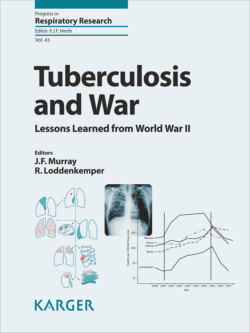Читать книгу Tuberculosis and War - Группа авторов - Страница 47
На сайте Литреса книга снята с продажи.
Crowding
ОглавлениеCrowded living favors increased transmission of tubercle bacilli [8]. Such conditions unfold during wartime among the civilian population and are inherent in military encampments. Typical examples during WWII include the destruction of the housing infrastructure by bombing as seen in London and other cities in the UK, and in Berlin and other large German cities. According to Sartwell et al. [9], “density of population 1.5–2.5 persons per room” and “a large number of [infectious] cases living at home” due to “the fact that before the close of hostilities patients with open TB had been generally permitted to work in factories and other industrial plants”. Similarly, owing to the dense congregation in bunkers, Long stated “In one bunker-type shelter in Mannheim (Germany), it is said that 18,000 people congregated during raids” [10] and in cellars during air raids, aggravated by loss of sleep and interference with meals [11]. Other examples include the close crowding in concentration and prison camps, in refugee camps, in the billeting and close-quarter accommodations, and in facilities such as military assembly and training camps.
Crowding was often aggravated by the influx of diseased prisoners of war (POWs) or of foreign (slave) workers from high TB incidence countries. Large population movements and the many displaced persons with communicable TB worsened the situation further at the end of WWII, especially in Germany and the formerly occupied countries. Another example that increased the spread of TB was the absconding of fugitives with TB from Europe to Britain and to some non-belligerent countries (Ireland, Spain) during WWII [5].
Patients with infectious TB have often been discharged from institutional care too early, because TB hospitals and sanatoria were occupied by injured or otherwise incapacitated military personnel. Accordingly, these factors increased the risk of transmission to the civilian population considerably. In Germany, thousands of injured civilians crowded the hospitals after large bombing raids, contributing to the shortage in hospital beds [9]. Furthermore, in Germany due to the increasing requirement to augment the labor force, TB patients were forced to work, thereby reducing any chance of recovery and accelerating their path to a fatal outcome. With only a few limitations, even patients with contagious TB were considered capable to work. Other inhumane measures of accelerating death included purposefully starving moribund patients and shortening the lives of so-called anti-social cases in selected TB hospitals, which often were combined with those for patients with psychiatric disorders [12].
Interestingly, the significant rise in TB mortality between 1937 and 1947 in Bavaria, which is illustrated in Figure 1, was almost completely due to pulmonary TB; by contrast there was only a small increase in extrapulmonary TB (Fig. 2), possibly due in part to unavailable or insufficient diagnostic methods. This phenomenon was also seen in other German provinces: pulmonary TB ranging from 91% of all TB deaths in Berlin down to 82% in Hesse in 1947. In the U.S. Zone, 85% of the mortality was ascribed to pulmonary TB and 15% to TB of other organs. These proportions are identical with the figures for all of Germany over the 3-year period, 1935–1937 [9]. That the rise of TB deaths was caused mainly by pulmonary TB was also observed in other countries (see chapters 6–19).
The data from Bavaria confirm that the TB mortality during wartime and at the end of the WWII was generally larger in the cities than in the rural districts, as shown on Figure 2.
Fig. 1. Tuberculosis mortality in Bavaria, Germany, 1937–1947, adapted from [13], with permission of Springer.
Fig. 2. Increase of TB mortality in Bavaria, Germany, at the end of WWII, mainly in cities compared to rural districts, adapted from Ref. [13], with permission of Springer.
One of the reasons for higher TB mortality rates in large cities (Fig. 3) may be owing to either the prevailing insufficient food supply (or to the better provision of food in rural areas). In Berlin, for example, food shortages were presumably enhanced because of the difficulty in procuring food from the surrounding farmland [14]. A further reason was presumably that living conditions were less crowded in rural areas [9]. An additional reason for the exacerbation of the prevalence of TB in big cities such as Berlin was the considerable loss of housing accommodations by massive allied bombing raids after 1943. Meyer mentions that in the different districts of Berlin between 25 and 50% of houses had been destroyed, heaviest in industrial districts where the lower social classes lived [14]. Virtually the same pattern of destruction occurred in England where industrial cities were the main target of German bomb and V2 attacks.
